Charles Darwin must have been thinking about communications when he wrote the Origins of Species, because today it is survival of the fittest. At the core of successful communications is innovation in storytelling, technology and where the two intersect.
Canada’s media environment is at a crossroads. Traditional publishers are having their audiences pried apart by on-demand services like Netflix and by the proliferation of social media influencers. Fitting somewhere between all three groups (publishers, audiences and influencers) are brands who, through content marketing and communications efforts, are finding a new voice to speak directly to consumers like never before.
As communication professionals we need to work on the new; whether you work for a government or airline trying to manage a crisis, an agency seeking to position a client’s product, or a content creator hoping to attract views to your work — you are all in competition for the same readers.
In Innovation Imperative, you will read seven stories about professionals like you who are finding new ways to engage with their audiences. Read their stories to find new inspiration for success in this ever-changing media landscape.
Chapter 1: Redefining What Is Considered “Content”

The word “content” can conjure lots of different ideas to different people, but Ron Tite, CEO of the Tite Group, has one of the best definitions for content in 2016.
“Content is what people want to consume opposed to what people have to consume,” said Tite. (Click to tweet)
If you don’t broaden your horizons and up your game, your content will never be a must have. It will just be ignored. The difference today, accordingly to Tite, is we have universal choice. We aren’t passive in our content diets. We’re carnivores.
“We used to go directly to The New York Times or CTV to engage with content,” he explained. “Now content can come from anywhere or anyone, and we choose what we want to consume.”
For what you produce to become someone’s meal of choice, Tite shared three rules for creating impactful content that can apply to any medium.
1. Hire subject matter experts and make them editors
If you want to create the best content you need the strongest most experience voice possible to create it.

“You can’t hire a 25-year-old copywriter to write specialized content for a brand niche that requires decades of knowledge,” said TIte. “Nothing against a 25-year-old, but who you hire directly impacts the content you create.”
His answer to this content quandary for Johnson Insurance Group hiring Bruce Sellery, a personal finance expert with more than 20 years’ experience as a brand manager, and as BNN’s Bureau Chief in New York City, as the editor of the brand’s content marketing program produced by the Tite Group.
As the sophistication of content evolves, the traditional structures that honed award-winning journalism for generations will move into content marketing. Hiring people like Sellery to lead content production will become the norm. You need a general to win a war.
2. Serve specific communities
“Community today isn’t a set of geographic boundaries [but rather] it is a set of interests,” said Tite, who suggests you find people who share your interests and you begin to congregate online.
Find your niche by monitoring how audiences respond to and engage with your content on social media. You may find that this audience isn’t your target demographic so you need to look at your strategy or realign your product marketing to target the audience you have inadvertently built.
3. Find inspiration everywhere
A shark has to swim to keep breathing, as does a content creator. With so much focus on writing, don’t forget to keep consuming a diverse set of media. If you need somewhere to start looking, Tite points to comedian Louis C.K. who sells his own TV show Horace and Pete’s on his personal website promoted through his proprietary email list.
“He owns the entire distribution; he owns his audience,” said Tite. “What brands need to understand is that we’re not just competing for people’s dollars anymore, we’re competing for their time.”
With competition like Louis C.K., we all have some work to do.
Chapter 2: Why Communicators Need To Be H.O.T.
Trust is the foundation of every great relationship. When a public organization like the Toronto Transit Commission (TTC) loses that, it can impact a city or government for years to come. Trust is measurable and can be lost in an instant.

To maintain that trust with the community, TTC’s Executive Director of Corporate Communications Brad Ross says that corporate communicators need to be H.O.T.--honest, open and transparent.
In 2010, the City of Toronto faced a $100 million class action lawsuit levied by aggrieved business owners along the St. Clair street car line after mismanagement of the upgrade and repair project of the line by a third party contractor that caused delays and thereby affecting revenue for the businesses along the line.
“The TTC’s portion arrived on-time and on-budget, but there was a misconception that it was [entirely] our project,” said Ross.
Since then, the organization has launched a new community relations framework called the Good Neighbours Policy, which outlines how the TTC must consult and communicate with affected communities before and during construction.
At the core of this strategy is listening to and measuring the community’s response to the group’s work.
How to measure H.O.T.:
The TTC uses Twitter, email alerts, video screens at rail stations, and its employees at transit stations to directly inform passengers about ongoing delays in the system. One of the greatest challenges the transit authority faces is measuring the community’s response. Here are five tactics Ross uses to overcome that hurdle and determine the effectiveness of his team’s transparency efforts.

1. Eliciting quarterly customer satisfaction surveys
By regularly doing this type of survey, the TTC can build a series of benchmarks for future internal evaluation. Any brand can do this. Some use surveys such as a Net Promoter Score, or NPS, to evaluate the likelihood customers would recommend a product to their family or friends while others take the grassroots option of SurveyMonkey.
Deploying these takes time and the findings may surprise you, but if you don’t know about a problem you can never fix it.
2. Benchmarking social media engagement
Even if you don’t ask your customers whether they are happy with your service, it doesn’t mean they won’t let you know. Ross’s team closely monitors Twitter, the go-to platform for most customers to voice their immediate concerns, on real-time nearly 24-hour basis. An increase in complaints is a strong indicator that a service disruption has not been communicated to the public effectively.
Social listening allows you to identify service issues and direct concerns to the appropriate service channel immediately.
3. Monitoring call volumes into TTC information lines

Don’t forget about phone calls! Every organization has customer service lines and, as professional communicators, you should be aware of the volume and content of those calls. Every touch point between a brand and its customers should be measured as an opportunity to bring value and build trust.
As an example when the TTC's new construction project, the Leslieville Barns kicked up dust in the summer, resident complaints were met with immediate action. (Click to tweet)
“We delivered air conditioners to those affect so they could close their windows and sill stay cool,” said Ross.
The TTC could do that because it listened and responded. Put data behind the types of issues that arise with your brand and identify problems that you have to solve.
4. Tracking direct person-to-person consultations
Consultation is the bedrock for a public organization’s engagement with residents. Measure the number of people who attend a consultation, record the issues raised and evaluate how these two are interrelated. Under the Good Neighbours Policy this meant creating a staffed site office that featured all the information about the Leslieville Barns project and had team members available to answer the community’s questions and take-in feedback.By having staff on-site, the city could be immediately aware of any issues as soon as they arose and relationships could be built with community members to make the situation less adversarial.
Not every aspect of a project can be up for the community to decide, but measuring the content provided by the community can direct future communication and awareness efforts. When you communicate uncomfortable truths clearly and consult with the public earnestly, you will face less vitriolic opposition.
Chapter 3: Crashing Through Crisis With Clarity
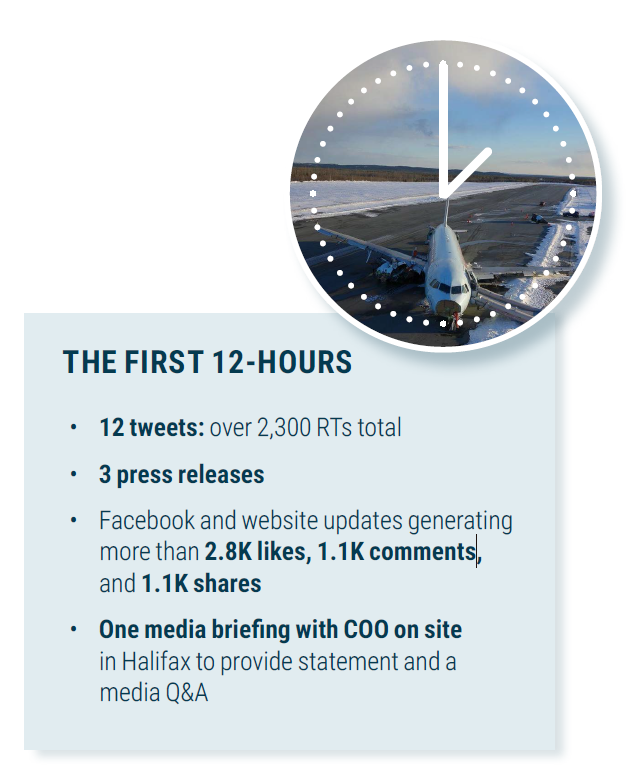
Being H.O.T. becomes even more important when lives are at risk. John Reber, Director of Communications at Air Canada, saw this first-hand when Flight AC624 incident on March 29, 2015 at 11:43 p.m. EST.
The passenger jet flew into Halifax, Nova Scotia with 133 passengers and five crew members. However, the plane missed the runway, smashing through an antenna that caused the landing gear to separate from the aircraft, and hit a power-line before skidding to a stop. The last encounter finally damaging the plane's fuselage and engines.
With all of that communication, misconceptions still occurred.
Stay up-to-date on brewing crises with real-time social media monitoring.
“A statement by a representative at the airport not affiliated with Air Canada called incident (crash) a ‘hard landing’,” said Reber.
This misattribution became the story for more than a full day.
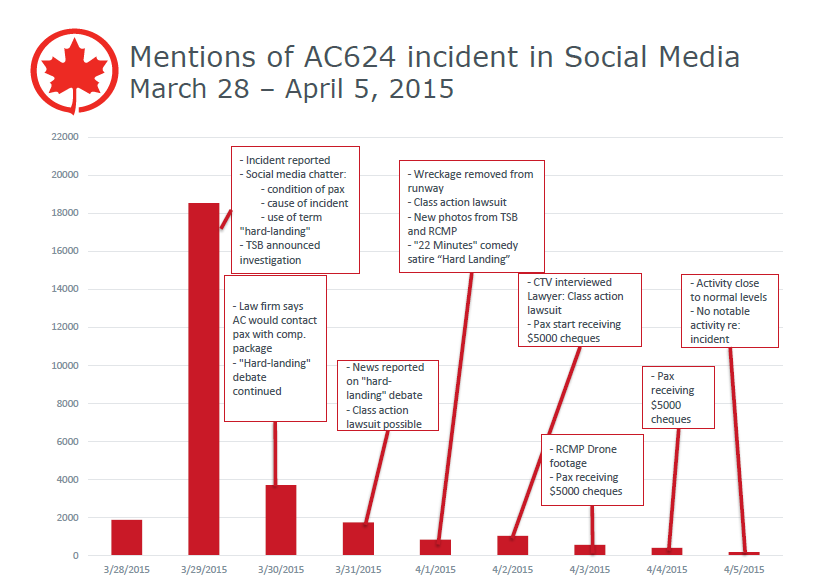
During the first 24 hours of the crisis, the airline received 18,000 social mentions—a 1,800 per cent increase from its daily average of 1,000 prior to the crash. With no serious injuries, the communication effort became damage control.
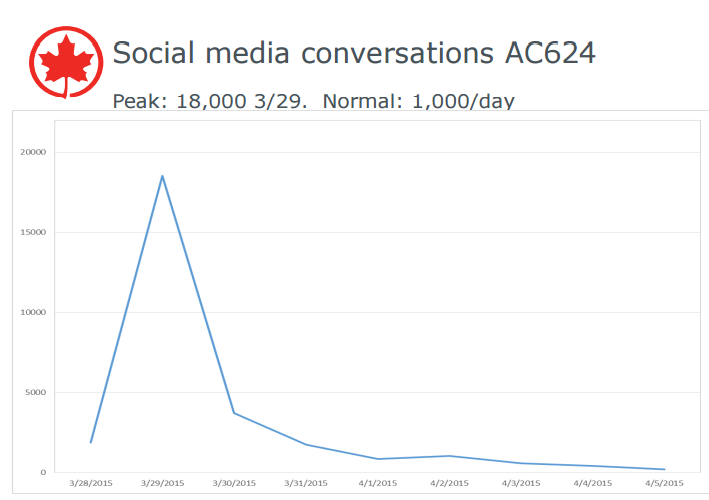
Here are four things any brand can do to mitigate a communications crisis
1. Provide immediate response

Manage the message and identify trends in the conversation that could further damage your brand.
In less than an hour Air Canada had sent its first tweet to the public about the crash--it is better your voice than someone else’s—and updated the public through Twitter every hour using the hashtag #AC624.
“By filling a communications vacuum [with scheduled updates], even in the middle of the night, coverage largely consisted of the facts as provided by Air Canada and the Transportation Safety Board,” said Reber.
2. Maintain consistency in messaging
Get the messages shared by executives, media relations teams and on social media aligned so that there is no confusion and to maintain your brand’s storyline. Anyone checking Twitter, Facebook or Air Canada’s website received the exact same information. Brief your team as new information is made available before giving the go-ahead for release.
3. Keep a senior executive on-site
In a crisis, the public wants your brand’s executives to be on-site and engaging in the conversation.
Klaus Goersch, Executive Vice President and Chief Operating Officer at Air Canada, took part in the media briefing during the first hours of the incident. This kept Air Canada’s voice as the focus of the attention and helped publicly show that action had been taken, accountability maintained and the situation remained under control.
“Empathy is the primary goal of communications at this point,” said Reber, commenting on his strategy for the press conference. “We wanted to show that we care and that we are here to help.” (Click to tweet)

4. Actions speak louder than words
When a plane crashes, people have lost—while hopefully not their lives—clothes, cellphones, laptops, and other personal items. Family members need to be notified and belongings replaced. Air Canada’s Special Assistance Team personally delivered items they could find to those passengers. Secondly, each passenger received a cheque for $5,000 by April 4, less than a week later.
“The follow-up stories covered our response to the incident,” said Reber. “No one had been hurt seriously and our team stayed in constant contact with families and those affected directly.
In a crisis, communicate first, communicate often and take action. That’s what will protect the brand and it also happens to be the right thing to do.
Chapter 4: Social Crisis Response For When Hell Freezes Over

When Toronto shut down because of a record breaking ice storm on December 21, 2013, Toronto Hydro’s Director for Media Communications and Municipal Stakeholder Relation Brian Buchan had a plan. Bring the team together and communicate with everyone through every channel possible with a single voice.
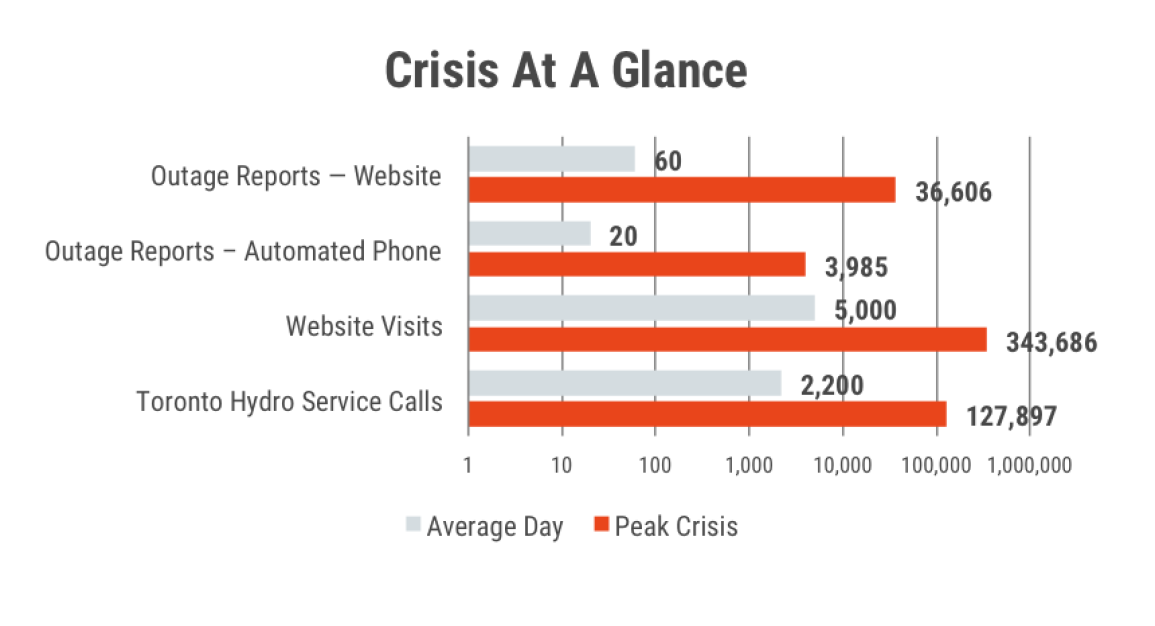
How did he do it? His team used a social media management tool and trained hard.
Toronto Hydro manages electricity for more than 700,000 customers affecting about 2.8 million people in the city.
“During the peak of the ice storm, more than half of our customers were out of power, 800 traffic lights were out, and 500 live wires were down on Toronto streets,” said Buchan. “Our number one concern was the public’s safety.” (Click to tweet)
The outage reports increased by 6,100 per cent, website traffic grew by 680 per cent and that’s while 416,000 customers were without power. When an emergency strikes, communication requirements skyrocket. Because ice storms are predictable—it’s more a matter of “when” rather than “if”—Toronto Hydro has an emergency plan in place that includes social media guidelines. Knowing the right messaging and means of communication helped Buchan’s team respond to hundreds of messages an hour and with accuracy.
Buchan’s Crisis Social Response Guidelines:
1. Respond to everything as quickly as you can
While you may not have people’s lives in your hands, this still means preventing further messages than can enflame a social media crisis. Arm your team to respond quickly in an emergency by preparing a response library for the usual types of complaints or issues that arise. Keep this as a living document during a crisis so teams can update it as new issues arise.
“We had teams from outside of marketing and communications help respond on social media,” said Buchan. “Planned responses help speed up the process and keep everyone aligned. “
2. No cherry-picking Respond to everything.
You can’t pick and choose the messages that you want to respond to whether its praise for your handling of the situation or a complaint. In case of the latter, try to move the conversation offline as soon as you can and direct that person to someone in your organization that can help fix the situation.
While the critical messages during the ice storm centered on the location of down trees and power lines being relayed to repair teams, for your brand it could be critical service requests. Connect with everyone who engages with your brand and help them find resolution.
3. Don’t spin the message
When something has gone wrong and it is being worked on, stick to the facts. If your brand is having a service outage and you don’t know how long it will take to repair, tell people that.
Social media managers had to respond to questions from residents about how long it would take to restore power to their homes or communities during the ice storm. Being accurate became integral to people’s comfort.
“If you tell someone it would take three days, they can prepare for that,” said Buchan. “If it then takes a full week, you’d force people to scramble to make other arrangements.”
Keep the lights on by keeping your staff full and people trained. Otherwise, your brand’s version of downed power lines will become unmanageable.
Chapter 5: Selling Video as a Communications Medium

Agencies are often asked to communicate for public organizations and when the Nova Scotia Power Authority wanted to inform the province of steps to take to maintain safety during a winter storm, Stephanie McGrath, National PR’s Director of Content Strategy pitched a video series.
This isn’t just because video is latest hot medium for storytelling, but rather McGrath felt that it would be the most effective way to communicate the power authority’s message. It would be direct, entertaining and measurable.
“We (communicators) need to stop talking about things like marketing, or PR, or communications,” said McGrath. “Instead what you want to convey is that communicating through your suggested tactics will be useful and effective.”
The Storm Wars Trilogy video series worked garnering sizeable shares on social media and even earning McGrath a Golden Quill Merit Award through the International Association of Business Communicators.
Selling clients on the idea of web series or even a single video requires practitioners to have two things on hand:
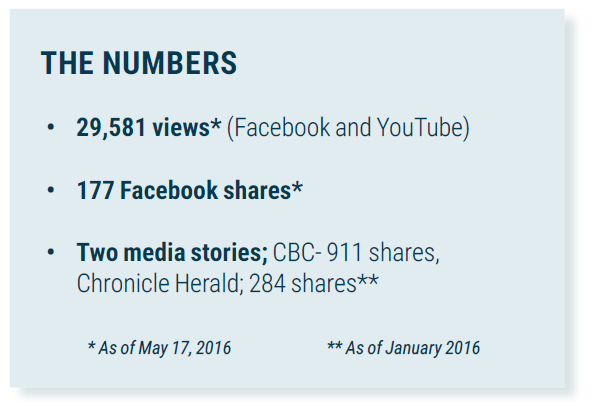
1. Examples, examples, examples
When you present to a client, find examples of how a similar campaign has worked for a company in their industry. These don’t have to be your own work, nor only from Canada, but they should illustrate that your campaign concept can work.
“My advice would always have backups,” said McGrath. “Have multiple examples of other companies in similar verticals that have done things like this and have been successful.”
2. An understanding of the audience
You should know as much about your client’s target audience demographic as you do about your client. For McGrath, she lives in Nova Scotia so she is the target audience. However if you don’t have that imbedded knowledge, you can collect consumer insights through a social media persona analysis.
“Research what your audience wants and what the organization and corporate objectives are,” said McGrath. “Tie both the audience’s needs and the organization’s goals together and present that to your clients.” (Click to tweet)
Here is what McGrath knew about her Nova Scotia audience going into the project:
- Nova Scotians have an affinity for a local named Frankie McDonald – who shares loud, eccentric ad hoc weather reports and has a passionate digital following. Featuring Frankie at the beginning of the first video in the series would help the series reach its target audience.
- Nova Scotians widely use the #StormChips hashtag – a province-wide inside joke that discusses how residents eat during a storm. Vegetables need not apply. She used this as a theme throughout the video series.
This works because it is localized. It isn't a web series for all of the country to learn about what to do during a power outage or a storm but instead is content for Nova Scotians about how to act when the coastal province has a storm.
Niche content in any format will outperform broader messaging within that niche. Think back to our shark analogy
Chapter 6: Hacking Into Your Audience with Video

You’ve got the buy-in from your client, now it’s time to convince the audience to watch your video. Twitter, Facebook, YouTube, LinkedIn, Vimeo, YouTube, and Instagram are all using moving pictures as a content vehicle. Brands that aren’t using video are losing out. Facebook even gives preference in its algorithm to live-streamed video. But the old-fashioned pre-recorded stuff will work well for you too.
When brands invest in video content, the worst thing that can happen is for the content to fall flat and the investment in money and time seems like a waste. Kevin Keane is the Co-Founder of Brain Sights a neural analytics company that studies the brainwaves of people watching video or otherwise engaging with content. Keane can track when you a viewer is engaged and when they drop off based on electroencephalogram (EEG) scans made multiple times a second that can even detect when memories are encoded into the brain and, most importantly, when they are not.
Keane’s team has looked into the minds of thousands of people and, after years of reviewing how people respond unconsciously, he has two keys for successful video content that can hack your brand’s messaging into anyone’s brain.

1. Don’t apologize for advertising your brand
“We see brands invest millions into commercial creative to then only make a brand reveal at the end of the video,” said Keane.
According to Keane’s research, this queues the audience to stop paying attention, illustrating that the content you need to pay attention to is over and you can go back to playing with your phone. Don’t do it! Instead, integrate your brand into key moments of your content.
“Make your brand the focal point of the most impactful and emotional moments,” he says. (Click to tweet)
This plays out everywhere, whether it is in your press releases, company events or on your blog. You’ve created these content experiences to help people become exposed to your brand – help them do that.
2. Context boosts relevance
People respond to content differently depending on where they are physically, the platform utilized to engage, and the content that comes before and after what they are reading. In each environment, a piece of content can be more or less effective.
“Super Bowl ads that matched the intensity of the game were as much as twice as effective as those that were slower paced,” said Keane, who conducted analyses of the highly coveted commercial spots for the past two title games.
If you are planning for your content to be engaged with alongside a hockey game or in a sports magazine, include the target sport in your content.
“If you are making significant investments in content or ad placement, you need to find media integrations that will maximize that content’s impact,” said Keane. Doing this requires that you plan each engagement carefully. You can’t copy paste one piece of content from one context to another and expect positive results.
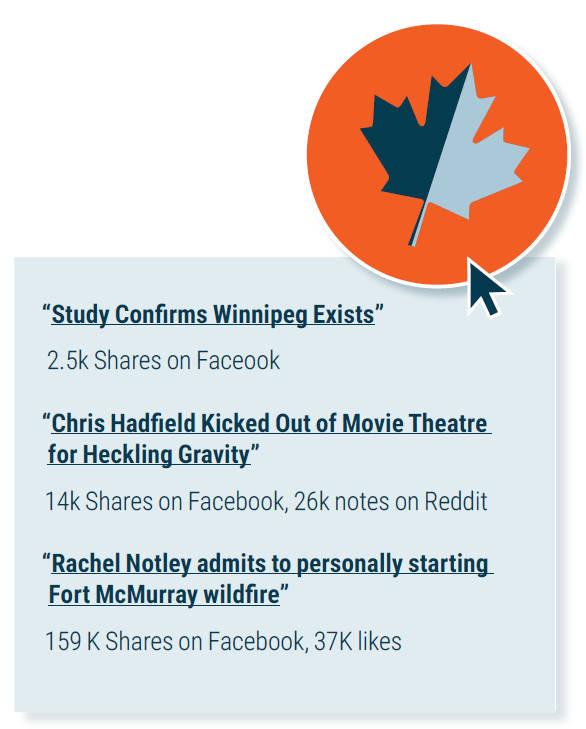
Chapter 7: Writing Viral Stories Takes a Village (and Luck)
Writing satirical news stories is all fun and games until a story crashes the server and propels your brands to worldwide recognition. Alexander Huntley is a staff writer with Canadian satirical news site The Beaverton, an online publication staffed by volunteers from across Canada that holds its story meetings on a private Facebook group and chooses its headlines democratically using ‘likes’.
If you spend any time on Facebook and are in the communications industry you’ve seen the team’s handiwork.
For a team of volunteers, the group is doing extremely well with stories going viral and even being included in international news as fast. Huntley shared his team’s secrets for creating consistently viral content.
1. Write headlines as a group
Ideas in isolation are only as good as the individual writer but when brought to a team of creative professionals, good ideas can be made great and mediocre ideas can be discarded.
“We have story meetings on Facebook, where we’ll write up headlines around a news item and vote by liking the most entertaining or catchy titles,” said Huntley.

The real business of fake news is found in writing and editing as a team. You can do the same with your blog ideas by bringing your subject matter experts and creative teams into the content process.
Huntley wrote about Canadian astronaut Chris Hadield with the headline, “Hadfield Arrives Back to Earth With $1.75 million Rogers Phone Bill.” The article actually broke the website with more than half a million hits in a day. Reddit users reposted it more than 20,000 times times .
“A Chinese newspaper reported it as true,” said Huntley. “The reporters [clearly] missed our disclaimer stating that the piece is satire.”
2. Real-time content has the greatest value
If your team has an idea to that is, at all, time sensitive strike while the iron is hot and get that story online. (Click to tweet)
Beaverton authors pitch two types of stories, those that are evergreen, which are comedic at any time and those that are pulled from the headlines. It is the later that often go viral.
“We can have a story online within half-an-hour of a news item dropping,” said Huntley, who often other beats mainstream publishers to the punch that are following up on a broken news item.
Of course not writing facts or having to quote actual people helps but the lesson is clear — get your content online fast. Popular stories on the Beaverton will often see more than 500,000 page views in a day when there is a high point in news coverage.
3. Be cognisant of tone and audience
If a story goes viral because it is offensive, you will have missed your mark and might create a social media crisis. (You read about handling those in Chapter 4 remember?) More often than desired, content can inadvertently be targeted to the wrong audience. Not all traffic is good traffic so remember who your audience is and what type of content they prefer.
While The Beaverton doesn’t pull its punches, it selects whom it hits with a simple editorial standard — don’t hit the little guy.
“It isn’t that we won’t write a piece that touches on controversial subjects, but when we feature any minority groups we take a counter-intuitive angle to the story,” said Huntley who called out a piece titled “First Nations Audit Reveals Federal Government Wastes Billions.”
The story flipped criticisms about First Nations Peoples back onto the government’s mismanagement of funds. The article received more than 20,000 shares on Facebook since its publishing in January of 2015, proving controversy can be an effective amplifier but you have to be careful.


